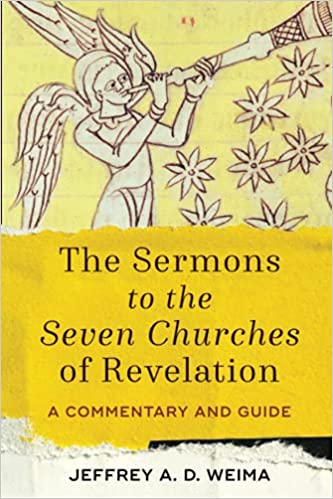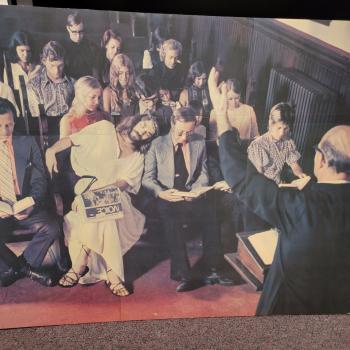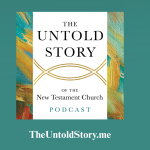Jeff Weima’s helpful guide to Rev. 2-3 is now widely available and I am happy to commend it to one and all. It does a fine job of exegesis of the material, of recognizing we are dealing with sermons, albeit with epistolary prescripts, and so are not really letters. Jeff is not only good at helping us understand the meaning of these much debated chapters, but takes the next step as well and helping us understand how to preach this material today to very different audiences at a very different time in the history of Christianity. This guide is substantial, over 300 pages in length, and reflects long and detailed reflection on the material itself and its various kinds of interpretation.
In this post I would like to say a bit more about sermons in the NT, and revisit some of the remarks I made back in 2006 on this subject in my Letters and Homilies for Hellenized Christians Vol. One. The following is some excerpts and extra comments from that discussion found on pp. 38ff. of that volume:
“We need to understand from the outset that ancient sermons may have looked quite different from modern ones. For example, ancient sermons were not necessarily expositions of a particular, or even two or three, Biblical texts. Of course there was no NT when the NT writers were living, and thus for them the OT was the sacred Scripture (see 2 Tim. 3.16).
But even so there were early Christian sermons based on a variety of resources. There were of course sermons based on OT texts, but also sermons based on early Christian tradition including the Jesus tradition, and sermons based on general Biblical themes. Also there were rhetorical discourses using all kinds of resources to mention just several possibilities. Expository preaching of the Bible was not the only thing going on in the first century world of Jewish or Christian preaching. Where then should we begin to explore this matter?…
Jewish sermonizing, which took place in synagogues (see e.g. Luke 4) tended to have practical and ethical focuses. They did not tend to be long theological discourses, but rather applications of certain OT texts.
“What comports with this picture is what we find recorded in Luke’s synopses of synagogue sermons offered by early Christians like Paul. We may compare for example Acts 13.15-41. Notice in the first verse that there is an invitation to offer “a word of exhortation” (logos parakleseos), the very same phrase used to describe the highly Jewish and textually oriented discourse we call Hebrews (Heb. 13.22). This suggests that at least one form of synagogue homily involved paraenesis based on Scripture exposition. In other words, it had an ethical and practical aim, it was not just an expounding of interesting ideas. This is hardly surprising since early Judaism was more focused on orthopraxy than orthodoxy.[1]
- Wills, in an important essay, has argued that this ‘word of exhortation’ form of homily had in fact three parts: 1) the exempla which was a reasoned exposition of the main thesis, usually with illustrations from one or more Scriptural text. This exempla laid out the facts, sometimes in narrative form and illustrated them. This was followed by 2) the conclusions based on those facts laid out in the first part of the homily. This section was introduced by words like dio (therefore), or dia touto (through or because of this) or some other Greek particle or conjunction. This conclusion was then followed by 3) an exhortation usually with imperatives.[2]
It is argued that this three part form can be seen in the following Jewish and Christian texts—Wis. Sol. 13-15; Test. Reub. 5.1-5; Test. Levi 2.6-3.8; Test. Benj. 2.5;3.1;6.6;7.1;8.1; Acts 2.14-40; 3.12-26; 13.14-41; 20.17-35; 1 Cor. 10.1-14; Heb. 1.1-2.1; 1 Pet. 1.3-11; 1 Clem. 6.1-7.2; 42.1-44.6; Ignatius of Antioch Ephesians; and the Epistle of Barnabas. Building on the work of Wills, and to some extent critiquing and refining it, C.C. Black noticed that in fact this threefold pattern is an ancient rhetorical pattern such that the first part of the homily in fact corresponds with the rhetorical ‘narratio’ the second major part corresponds with the proposition and the arguments based on the narration (‘probatio’), and the final exhortation corresponds with the peroration. In fact this form reflects a primitive sort of deliberative rhetoric where one is trying to modify the audience’ s belief or behavior in some way in the near future.[3]
This following of a rhetorical format in early Jewish and Christian preaching should in no way surprise us. It was part of the harvest of Hellenism even in Israel. The rhetorical handbooks or guidebooks to persuasive speaking in Greek had been in circulation from the 4th century B.C. and there can be no doubt that this heavily influenced even early Judaism. In fact one may see the Qumran community as a reaction to the over-Hellenization of early Judaism in Jerusalem. But their protest did not stem the tide of Hellenization. The building program of Herod the Great was intent to turn Jerusalem into a cosmopolitan city influenced by Greek culture, as the building of the theater and the hippodrome right in the shadow of the Temple makes evident. There was in fact a school of rhetoric right in Jerusalem during Paul’s day, and we need not doubt it affected the preaching of those who spoken in synagogues where Greek was spoken, including in Jerusalem.[4]
We must also reckon with the influence of Jewish schooling in a more general sense as well. Speaking of students at a Sabbath school in Alexandria Philo tells us that what was taught these students was the following—“they were trained in piety, holiness, justice, domestic and civic conduct, knowledge of what is truly good or evil, or indifferent, and how to choose what they should do and avoid the opposite, taking for their defining standards these three— love of God, love of virtue, love of people” (Every Good Man is Free 83). This almost reads like a summary of many of the major topics discussed in these early Christian letters and homilies (see e.g 1 John), and we may be reasonably sure that these same sorts of topics of orthopraxy were regularly preached in the synagogues, as well as in early Christian house churches.”
“Of course it is the case that not all early Christian sermons followed a rhetorical pattern. One would be hard pressed to find such a pattern in some of the relevant NT material. What we can say at this juncture is that 1 John, James, Hebrews, and probably Jude should all be seen as homilies of one sort or another, with Hebrews most closely following rhetorical conventions. These documents either have no, or very minimal epistolary elements, and should never have been analyzed primarily as letters in the first place. On the other hand we have the Pastoral Epistles (perhaps excepting 1 Timothy, which is more of an exhortation), 2 and 3 John and 1 Peter which definitely can and probably should be analyzed primarily as letters. This is the sort of genre division of material which will guide our study in these two volumes.
What is important to recognize about all these documents is that they are intended to be pastoral in character and are not theological or ethical treatises in any case. Their uses of Scriptures and other resources are primarily homiletical rather than exegetical in character by and large and what we actually find in these documents is not theology and ethics but theologizing and ethicizing into specific situations, hopefully in a persuasive manner. These documents are, by and large, words of exhortation, with ethics and practical matters to the fore, though theology is also not neglected.
If we ask what is the real importance of these documents tucked away towards the back of the NT canon, we can answer that they are very important. They give us a window on early Christian life between the middle of the first century and the early second century A.D. Indeed they are some of the very few resources that directly deal with this largely hidden period of time. Acts, as we are well aware, stops its narrative in about A.D. 60-62 with Paul in Rome and it is the only historical monograph we have from and about the first century church. The Gospels while written later do not provide direct evidence, only indirect evidence, of what Christian communities were like in the last third of the century. In this regard they are unlike these sermons and letters which do provide a more direct window into this important period as the apostles were passing away and the torch of Christian faith was being passed to another generation. While the Book of Revelation, especially Rev. 1-2, does give us a glimpse of church life in the 90s in Asia, it is only a glimpse in passing, for John’s focus is primarily on the future. There is much to be gained from close analysis of this material if we are to understand the end of the apostolic era, and how the transition was made to a time when there would no longer be apostles. But there is another reason why this literature is crucial.
In her detailed and brilliant lectures A. Cameron has shown that Christian discourse going all the way back to the first century A.D. and forward into the Middle Ages was a discourse that was shaped by and sought to shape society. It was not shaped merely by and for its own conventicles and churches. Christianity was profoundly an evangelistic enterprise and so it is not a surprise that it would adopt and adapt the familiar and popular forms of speaking and writing of the day, and use them to its own ends to convict, convince and convert many for Christ. Cameron aptly says:
‘Christianity was not just ritual. It placed an extraordinary premium on verbal formulation; speech constituted one of its basic metaphors, and it framed itself around written texts. Quite soon this very emphasis on the verbal formulation of the faith led to a self-imposed restriction—an attempt, eventually on the whole successful, to impose an authority of discourse. And eventually—though only after much struggle and with many variations—this approved discourse came to be the dominant one in the state. The story of the development of Christian discourse constitutes part of the political history… Early Christian rhetoric was not always…the specialized discourse its own practitioners often claimed it to be. Consequently its reception was easier and wider ranging than modern historians allow, and its effect correspondingly more telling. The seemingly alternative rhetorics, the classical or the pagan and the Christian, were more nearly one than their respective practitioners, interested in scoring off of each other, would have us believe.'”[5]
The fact that Revelation was copied, and widely circulated in early Christianity, to the extent that it was much debated well into the 4th century as to whether it was apostolic in character, and even if it was, whether it should be included in the NT canon (a debate that continued even into the Reformation, when there was little understanding of the nature of Jewish apocalyptic prophecy) demonstrates that this material was not just seen as preaching to the choir. It was also seen as having some evangelistic and missional import, and in fact it still does as Jeff’s helpful study amply demonstrates.
—–
[1] Though it is clear enough from Saul of Tarsus’ zealotic activities against Jewish Christians that orthodoxy was of some concern as well— see Gal. 1.
[2] F. Wills, “The Form of the Sermon in Hellenistic Judaism and Early Christianity,” HTR 77 (1984), pp. 75-99.
[3] See C.C. Black, “The Rhetorical Form of the Hellenistic Jewish and Early Christian Sermon: A Response to Lawrence Wills,” HTR 81 (1988), pp. 1-18, and Witherington, Acts , pp. 406-407 on Acts 13.
[4] On this matter see Witherington, The Paul Quest, (Downers Grove: InterVarsity Press, 1998), pp. 90-98, M. Hengel The Pre-Christian Paul, (Valley Forge: Trinity Press Int. 1991), pp. 54-60. On the whole issue of Judaism and Hellenism the classic study is of course M. Hengel’s Judaism and Hellenism (2 volumes: Phila: Fortress, 1974) to which one must add the supplement of his The Hellenization of Judaea in the First Century after Christ, (Phila: Trinity Press, 1989).
[5] A. Cameron, Christianity and the Rhetoric of Empire. The Development of Christian Discourse (Berkeley: U. Cal. Press, 1991), pp. 19-20.

















